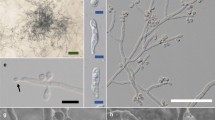Abstract
Inoculation of potato callus cultures with basidiospores of the cocoa pathogenCrinipellis perniciosa resulted in the development of a mycelium which was morphologically identical to that found in green cocoa brooms. These dual cultures could be maintained for periods of several months. The nuclear condition of this mycelium was found to be variable, in contrast to previous reports. Basidiospores of the L-biotype ofC. perniciosa were also able to form dual cultures, although a biotrophic phase in its life cycle has yet to be demonstratedin vivo. Attempts to form stable heterokaryons between genetically distinct biotrophic mycelia were unsuccessful.
Similar content being viewed by others
References
Aragundi JA (1982) Culture and histology ofCrinipellis perniciosa (Stahel) Singer. M.Sc. thesis, University of Florida
Bastos CN, Andebrahan T and de Almeida LC (1988) Comparação morfológica de isolados deCrinipellis perniciosa. Fitopatologia Brasiliera 13: 202–206. (In Portuguese)
Bastos CN and Evans HC (1985) A new pathotype ofCrinipellis perniciosa (witches' broom disease) on solanaceous hosts. Plant Pathology 34: 306–312
Boidin J (1986) Intercompatibility and the species concept in the saprobic Basidiomycotina. Mycotaxon 26: 319–336
Brownlee HE, Hedger JN and Scott IM (1990) Host extracts cause morphological variation in germ-tubes of the cocoa pathogen,Crinipellis perniciosa. Mycological Research 94: 543–547
Burnett, JH (1975) Mycogenetics. John Wiley and Sons
Calle H, Cook AA and Fernando SY (1982) A histological study of withches' broom in cocoa, caused byCrinipellis perniciosa. Phytopathology 72: 1479–1481
Croft JH and Dales RBG (1984) Mycelial interactions and mitochondrial inheritance inAspergillus. In: Jennings DH, Rayner ADM, eds, Ecology and Physiology of the Fungal Mycelium, pp 433–450. Cambridge University Press, Cambridge, UK
Delgado JC and Cook AA (1976) Nuclear condition of the basidia, basidiospores and mycelia ofMarasmius perniciosus. Canadian Journal of Botany 54: 66–72
Evans HC (1978) Witches' broom disease of cocoa (Crinipellis perniciosa) in Ecuador. I. The fungus. Annals of Applied Biology 89: 185–192
Evans HC (1980) Pleomorphism inCrinipellis perniciosa causal agent of witches' broom disease of cocoa. Transactions of the British Mycological Society 74: 515–523
Frias GA (1987) An inoculation method to evaluate resistance to witches' broom disease of cocoa. Ph.D. Thesis, University of Florida
Gray AB and Sackston WE (1987) Host-parasite relationships in dual cultures ofHelianthus annuus andPlasmopora halstedii. Canadian Journal of Botany 65: 2057–2060
Griffith GW (1989) Population Structure of the Cocoa PathogenCrinipellis perniciosa (Stahel) Sing. Ph.D. thesis, University of Wales
Griffith GW and Hedger JN (1993) A novel method for producing basidiocarps of the cocoa pathogenCrinipellis perniciosa using a bran-vermiculite medium. Netherlands Journal of Plant Pathology 99: 227–230
Griffith GW and Hedger JN, 1994a. The breeding biology of biotypes of the witches' broom pathogen of cocoa,Crinipellis perniciosa. Heredity 72(3): 278–289
Griffith GW and Hedger JN, 1994b. Spatial distribution of mycelia of the liana (L-)biotype of the agaricCrinipellis perniciosa in tropical forest. New Phytologist 127: 243–259
Hedger JN, Pickering V and Aragundi JA (1987) Variability of populations of the withces' broom disease of cocoa (Crinipellis perniciosa). Transactions of the British Mycological Society 88: 533–546
Ingram DS (1976) Growth of biotrophic parasites in tissue culture. In: Heitefuss R, Williams PH, eds, Encyclopedia of Plant Pathology, Volume 4, Physiological Plant Pathology, pp 743–759. Springer-Verlag., Berlin, W. Germany
Kay E and Vilgalys R (1992) Spatial distribution and genetic relationships among individuals in a natural population of the oyster mushroomPleurotus ostreatus. Mycologia 84: 173–182
McGeary FM and Wheeler BEJ (1988) Growth rates of, and mycelial interactions between, isolates ofCrinipellis perniciosa from cocoa. Plant Pathology 37: 489–498
Miller SA and Maxwell DP (1983) Evaluation of disease resistance. In: Evans DA, Sharp WR, Ammirato PV, Yamada Y, eds, Handbook of Plant Cell Culture, Volume 1, pp 853–879. Techniques for Propagation and Breeding. Macmillan, New York, USA
Murashige T and Skoog F (1962) A revised medium for rapid growth and bioassay with tobacco tissue cultures. Physiologia Plantarum 15: 473–497
Muse RB (1989) Physiology and biochemistry of witches' broom disease in cocoa (Theobroma cacao L.). Ph.D. thesis, University of Liverpool
Pegus JE (1972) Aspects of the host-parasite relationship in theTheobroma cacao L./Marasmius perniciosus Stahel disease complex
Rayner ADM, Coates D, Ainsworth AM, Adams TJH, Williams END and Todd NK (1984) The biological consequences of the individualistic mycelium. In: Jennings DH, Rayner ADM, eds, Ecology and Physiology of the Fungal Myceliumn, pp 509–540. Cambridge University Press, London, UK
Stephenson NA and Gooday GW (1984) Nuclear numbers in the stipe cells ofCoprinus cinereus. Transactions of the British Mycological Society 82: 531–534
Wheeler BEJ (1985) The growth ofCrinipellis perniciosa in living and dead cocoa tissue. In: Moore D, Casselton LA, Wood DA and Frankland JC, eds, Developmental Biology of Higher Fungi, pp 103–116, Cambridge University Press, London, UK
Wheeler, BEJ and Mepsted R (1988) Pathogenic variability amongst isolates ofCrinipellis perniciosa from cocoa (Theobroma cacao). Plant Pathology 37: 475–488
Author information
Authors and Affiliations
Rights and permissions
About this article
Cite this article
Griffith, G.W., Hedger, J.N. Dual culture ofCrinipellis perniciosa and potato callus. Eur J Plant Pathol 100, 371–379 (1994). https://doi.org/10.1007/BF01874805
Accepted:
Issue Date:
DOI: https://doi.org/10.1007/BF01874805




